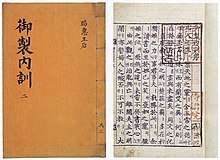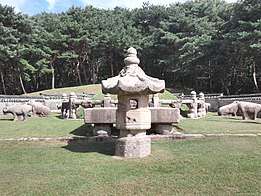Naehun
Naehun (Instructions for women, 내훈, 內訓) is the first known book written by a woman in Korea, it is a Confucian morality guidebook for women. The book is one of the most representative books which reflects social construction of gender and sexuality based on Confucian ideals in premodern East Asia.[1] It has a modern value in that it becomes a unique Korean history material with various Korean royal court vocabulary describing appropriate behavior for a woman in accordance with Confucian cultures.[2]
 First book written by a woman in Korea, 1475 National Treasure of South Korea | |
| Author | Grand Queen Dowager Insoo 7 October 1437 – 11 May 1504 (Cheongju Han clan) |
|---|---|
| Country | Korea |
| Language | Korean, Chinese |
| Genre | Introductions for women |
| Publisher | Joseon dynasty (1392–1897) |
Publication date | 1475 |
| Media type | Book |
Background
Grand Queen Dowager Insoo (posthumous Queen Sohye, 7 October 1437 – 11 May 1504) regretted that there were no educational books that women could read easily at that time, and she wrote this book by extracting the key points of the women's discipline from four books of Chinese classical books for women such as Biographies of Exemplary Women,[3] lesser learning, Mingxin baojian,[4] Chinese Introduction for women.
Introduction of Royal Consorts
This is an instruction book for women published in 1475 (year 6 of Seongjong) written by Grand Queen Dowager Insoo, a wife of king Deokjong (1438 – 2 September 1457, Korean: 의경세자). Queen Insu was a member of Cheongju Han clan family, appointed as the queen mother in 1475.[2] The most emphasized of the virtue of women in the Naehun is Intellectual, moral rectitude and capability to act as a counselors and to remonstrators to their men. Such portrayal of women suggest a subversive notion of a 'blurred' demarcation of the inner and outer sphere, private or domestic.[5] To justify those understanding, the book states for King and Queen, Men and Women's 'Speech and Component', Sitting, Eating, Walking, Conversation and so on.
Confucian morality for women
Naehun is the oldest known surviving work by a woman writer in Korea, however, it shows the effects of Confucian social values on women's status of the Joseon kingdom.[6] It is published several times at different times, and the notation, as well as the vocabulary and writing style change well, making it an important resource for the study of Korean medieval languages.[7]
The Book
At the head of the book is the Queen's letter of Instruction (내훈) and the list. The book is composed of 3 volumes and 7 chapters.
Volume 1 : Etiquette, Filial piety, Marriage
Volume 2 : Married couple
Volume 3 : Parents, Mother, Cordiality, Frugality
Queen Sohye's letter

"Humankind are born with the divine energy of heaven and earth, and contains the five virtue of man's virtues. The reason is not different from beads or stones. But why is there something unusual like an orchid or wormwood? It depends on whether or not you have done your best to cleanse yourself.
The enlightenment of the King Zhou of Shang, was further expanded in the wisdom of his wife, Daji. The king Yu of Zhou dynasty's supremacy was derived from the power of his wife, Bao Si. So who is better than this to serve the king and serve the husband?
Politics is ruling or dizzying, and the rise or fall of the country depends on the light and dark of husbands, but also on the good and bad of their wives. Therefore, we must teach well.
On the whole, a male plays in a wide and large mind, learns his will from various mysteries, and moves himself and discerns his wrong as a figure. So how would you wait to teach me and then do it?"
References
- Dorothy Ko; JaHyun Kim Haboush; Joan R. Piggott; Joan Piggott (2003). Women and Confucian Cultures in Premodern China, Korea, and Japan. CA: University of California Press. p. 166. ISBN 9780520231382.
- "Queen Sohye's Instruction for Women – Queen Sohye (Queen mother Insu, Seongjong's mother)". Google Arts & Culture. Retrieved 23 August 2019.
- Carlitz, Katherine (1991). "The Social Uses of Female Virtue in Late Ming Editions of Lienu Zhuan." Late Imperial China 12.2: 117–48". Late Imperial China : Qing Shi Wen Ti. doi:10.1353/late.1991.0003. ISSN 1086-3257.
- Léonard Blussé; Harriet Thelma Zurndorfer; Erik Zürcher (1993). Conflict and accommodation in early modern East Asia. p. 174. ISBN 90-04-09775-9. OCLC 469840618.
- Park, Si Nae (2005). Re-reading Queen Sohye's Naehun (Thesis). University of British Columbia.
- "MusicalAmerica - Terra Han introduces East Asian Royal women's identity through her own family traditions of Han clan of Cheongju". www.musicalamerica.com. Retrieved 12 May 2020.
- Kim-Renaud, Young-Key (24 February 2015). "The Naehun and the Politics of Gender in Fifteenth-Century Korea". Creative Women of Korea: The Fifteenth Through the Twentieth Centuries. doi:10.4324/9781315705378-9 (inactive 29 May 2020). Retrieved 23 August 2019.
- "Royal Tombs | Cultural Heritage Administration". english.cha.go.kr. Retrieved 12 May 2020.
- "MusicalAmerica - Terra Han introduces East Asian Royal women's identity through her own family traditions of Han clan of Cheongju". www.musicalamerica.com. Retrieved 12 May 2020.